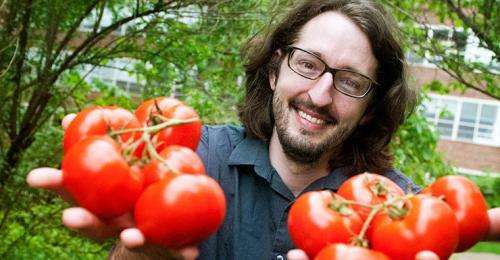America's tomato crush

A doctoral candidate in Penn State's Department of History, John Hoenig has focused his research on the evolution of the tomato industry, adding to our understanding of America's consumer culture.
Is there an item on the average household's dinner table so roundly scorned as the wintertime tomato? The plastic-like red globe is typically so barren of authentic taste and texture that it epitomizes the industrialization of food, says John Hoenig, a doctoral candidate in history at Penn State. Yet he points to that very same tomato as a symbol of victory—tangible evidence of Americans' success in transcending traditional patterns of seasonality in their diets.
Hoenig has made "the quest for the 12-month tomato" the focus of his research.
Farmers and consumers, rather than big business, drove that quest, he asserts. It's a notion that runs contrary to the views of most historians of food and agriculture, who use the tomato as an indicator of the cultural, political, and economic control that a relatively small number of large corporations have over the food Americans consume.
Canned or fresh?
"Evidence shows that the tomato industry did not follow the same route as the meat and grain industries, where a handful of corporate giants dominated production by the late 1800s," Hoenig explains. Although some historians have cited Heinz and Campbell's as proof that big business ruled the tomato, in truth those two companies marketed primarily ready-to-serve products, such as ketchup and tomato soup, and did little with fresh and canned tomatoes.
Canned tomatoes represent the other component in the search for the 12-month tomato. The canned product was desirable as a year-round staple because it could easily be adapted to most ethnic and cultural preferences for tomatoes as part of recipes for other dishes. On a per capita basis in 1920, a typical year, Americans consumed on average 27 pounds of canned tomatoes annually, Hoenig notes.
In the form of canned or fresh tomatoes, the industry was remarkably dispersed geographically and in ownership. Canning technology was relatively simple, and entry into the field did not require a huge up-front investment. In 1925, more than 1,500 companies nationwide canned tomatoes, and many of them operated multiple plants. Canneries had to be located close to farms, since ripe tomatoes did not ship well. Early in the 20th century, large quantities of tomatoes were grown commercially from New Jersey, Delaware and Maryland to Indiana and Illinois, and also in Florida and Texas. Tomatoes for fresh consumption included those raised in greenhouses, which further extended seasonal availability and supported decentralization among growers in the northern states.
"Many people think of having fresh tomatoes as a kind of post-World War II phenomenon," Hoenig says, "but fresh wintertime tomatoes were commonly available as early as the 1920s, though at prices that only fairly affluent families could afford. The Zuck Greenhouse in Erie, for instance, produced 150,000 pounds of tomatoes in 1924."
Those tomatoes may not have been especially tasty, Hoenig admits, but there was another factor in play besides the innate need to have food available year round.
Food is history
Hoenig describes himself as a cultural historian, rather than a specialist in food or agricultural history. He came to Penn State in 2007 after finishing undergraduate work at Southern Methodist University in his native Texas. He's studying with Gary Cross, Distinguished Professor of Modern History.
Hoenig says he's interested in food because "it gives me a way to delve into a variety of subjects and to look at the lives of ordinary people, not just the elites. I'm especially interested in how we as people change through the process of industrialization, and how our culture has shaped industrialization."
Around the time of World War II, the tomato industry started to catch up with meat and grain, becoming more centralized as many canneries went out of business or were bought out, and many farmers turned to other crops. Canned tomatoes from such giants as Hunts and Del Monte became staples on supermarket shelves from coast to coast. Hoenig's research is still a work in progress, as he continues to assess factors that underlay post-war centralization.
When asked what "take-away" his dissertation might have for the average consumer, Hoenig points to something called the "doctrine of natural advantage." In food production, the doctrine assumes that intense concentration of production—in this case, of tomatoes—is an inevitable result of the advantages of geographic location. Thus southern California has the advantages that best suit it as the nation's low-cost, year-round tomato-grower, Iowa is naturally an ideal place to grow corn for the nationwide market, Nebraska specializes in meat-packing, Idaho has the advantage for potatoes and so on.
Hoenig questions the validity of that assumption, noting that the history of tomato production suggests that concentration is not always the best course or the one that yields lowest cost. Tomato farmers and canners followed traditional methods and worked in a decentralized environment for nearly a century, and they satisfied consumers' desires. "The very fact that we have a 12-month tomato is proof of their success," he declares.
He emphasizes that he does not reject big business or corporate agriculture. Instead, the history of the tomato industry should make us think about the way our food culture has evolved and the way we want it to continue to evolve.
"We have a different culture for tomatoes than we do for, say, meat and grain, and we should recognize that," Hoenig concludes. "We think about tomatoes. We think about the varieties we want, how we'll prepare them, who we'll serve them to, how they might complement certain ethnic dishes, and so forth. The popularity of the organic and all-natural and buy local movements, and the ease of growing tomatoes in our own backyards, all mean that the tomato industry will continue to be decentralized and dispersed to a significant degree."
Provided by Pennsylvania State University



















